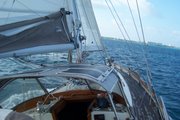Most boats today are designed with or outfitted out with a roller furler or boom furler... Many people cannot remember a day with out roller furlers... The boat I learned to sail on, a Simpson Wild Shifter Mk II, did not have a roller furler... We raced and cruised with hank on sails and had to fold them every time we changed sails... There were different size sails for different wind strengths, not having the standard 150% genoa rolled up to a 135% or even a 90% jib... My dad's last sailboat, a Condor 40, came with a standard roller furler... It quickly became a learning experience... Some of the problems we encountered, we figured were typical issues... they were only "typical" because some things were not set up correctly... We had professionals do work on the boat and nothing was ever said about the set up of the furler... I look back and realize how dangerous that could have been...
One of the main things I look for when inspecting a roller furler is if a halyard restrainer is present & installed correctly... The halyard restrainer is designed and installed to change the angle of the halyard to be different than the headstay angle... Typically, if the halyard swivel is greater than 6 inches from the halyard sheave, there is a large possibility the halyard will wrap and cause problems with the roller furler...
There are several different designs of halyard restrainers; some are a single stainless steel "clam shell" design, some are designed with a "rolling sheave", some designs use a "donut" and others use "eye straps"... Each design has a pro and a con...
The "rolling sheave" allows the halyard to roll easier, but has straight sides where the halyard may chafe if pulled to the side... The "eye strap" design is good for small boats because of its small and compact size, but allows chafe on the halyard... The "clam shell" design has smooth entry and exit that resists chafe, but adds a little drag when raising and lowering halyards... The "donut" designs push the halyard away from the headstay, but need to be engaged correctly or they can cause the same problem as not having a restrainer at all...
I have seen examples where a 90# woman winched a roller furler in and twisted the extrusions like a pretzel... The halyard had wrapped and locked up the roller furler unit and when she continued to winch the jib in, it destroyed the entire system... I have seen jib halyards torn apart, headstays cut in half and a variety of damaged extrusions...
Friday, March 9, 2007
Subscribe to:
Post Comments (Atom)

2 comments:
Hey this is a great find. Keep publishing please.
George
Is a very interesting article - we learned some things about your trip that we didn't know previously!
We especially liked the pictures of our adventurous Grandson!!
The Inlaws!
Post a Comment